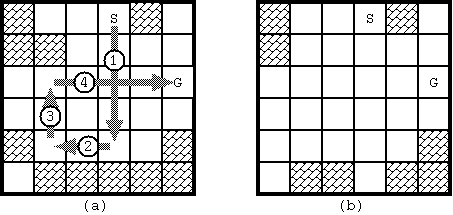标签:des blog http io ar os sp for strong
| Time Limit: 1000MS | Memory Limit: 65536K | |
| Total Submissions: 12129 | Accepted: 5113 |
Description
On Planet MM-21, after their Olympic games this year, curling is getting popular. But the rules are somewhat different from ours. The game is played on an ice game board on which a square mesh is marked. They use only a single stone. The purpose of the game is to lead the stone from the start to the goal with the minimum number of moves.
Fig. 1 shows an example of a game board. Some squares may be occupied with blocks. There are two special squares namely the start and the goal, which are not occupied with blocks. (These two squares are distinct.) Once the stone begins to move, it will proceed until it hits a block. In order to bring the stone to the goal, you may have to stop the stone by hitting it against a block, and throw again.

Fig. 1: Example of board (S: start, G: goal)
The movement of the stone obeys the following rules:

Fig. 2: Stone movements
Under the rules, we would like to know whether the stone at the start can reach the goal and, if yes, the minimum number of moves required.
With the initial configuration shown in Fig. 1, 4 moves are required to bring the stone from the start to the goal. The route is shown in Fig. 3(a). Notice when the stone reaches the goal, the board configuration has changed as in Fig. 3(b).

Fig. 3: The solution for Fig. D-1 and the final board configuration
Input
The input is a sequence of datasets. The end of the input is indicated by a line containing two zeros separated by a space. The number of datasets never exceeds 100.
Each dataset is formatted as follows.
the width(=w) and the height(=h) of the board
First row of the board
...
h-th row of the board
The width and the height of the board satisfy: 2 <= w <= 20, 1 <= h <= 20.
Each line consists of w decimal numbers delimited by a space. The number describes the status of the corresponding square.
0 vacant square 1 block 2 start position 3 goal position
The dataset for Fig. D-1 is as follows:
6 6
1 0 0 2 1 0
1 1 0 0 0 0
0 0 0 0 0 3
0 0 0 0 0 0
1 0 0 0 0 1
0 1 1 1 1 1
Output
For each dataset, print a line having a decimal integer indicating the minimum number of moves along a route from the start to the goal. If there are no such routes, print -1 instead. Each line should not have any character other than this number.
Sample Input
2 1 3 2 6 6 1 0 0 2 1 0 1 1 0 0 0 0 0 0 0 0 0 3 0 0 0 0 0 0 1 0 0 0 0 1 0 1 1 1 1 1 6 1 1 1 2 1 1 3 6 1 1 0 2 1 1 3 12 1 2 0 1 1 1 1 1 1 1 1 1 3 13 1 2 0 1 1 1 1 1 1 1 1 1 1 3 0 0
Sample Output
1 4 -1 4 10 -1
Source
#include<iostream>
#include<cstdio>
#include<cstdlib>
#include<cstring>
#include<string>
#include<cmath>
#include<algorithm>
#define MIN(x, y) (x)<(y)?(x):(y)
#define MAXN 25
#define INF 15
using namespace std;
int w, h, result, map[MAXN][MAXN];
int dx[4] = {1, 0, -1, 0}, dy[4] = {0, -1, 0, 1};
bool in(int tx, int ty)
{
return tx >= 1 && tx <= w && ty >= 1 && ty <= h;
}
void dfs(int x, int y, int step)
{
bool out;
int i, tx, ty;
if (step > 10) // 终止条件
return;
for (i = 0; i < 4; ++i)
{
if (map[x+dx[i]][y+dy[i]] == 1) // 与石头相邻
continue;
out = false;
tx = x;
ty = y;
while (1) // 沿一方向滑行
{
tx += dx[i];
ty += dy[i];
if (!in(tx, ty)) // 一定要先判定出界情况! 这里WA了一次
{
out = true;
break;
}
else if (map[tx][ty] == 3) // 到达终点
{
result = MIN(result, step);
return;
}
else if (map[tx][ty] == 1) // 打到石块
break;
}
if (out) // 出界则剪枝
continue;
map[tx][ty] = 0; // 破坏石头
dfs(tx-dx[i], ty-dy[i], step+1);
map[tx][ty] = 1;
}
}
int main()
{
int i, j, s_x, s_y;
while (scanf("%d%d", &w, &h), w && h)
{
for (i = 1; i <= h; ++i)
for (j = 1; j <= w; ++j)
{
scanf("%d", &map[j][i]);
if (map[j][i] == 2)
{
s_x = j;
s_y = i;
map[j][i] = 0; // 找到起点后清空该位置
}
}
result = INF;
dfs(s_x, s_y, 1);
if (result == INF)
printf("-1\n");
else
printf("%d\n", result);
}
return 0;
}
标签:des blog http io ar os sp for strong
原文地址:http://www.cnblogs.com/a972290869/p/4101049.html